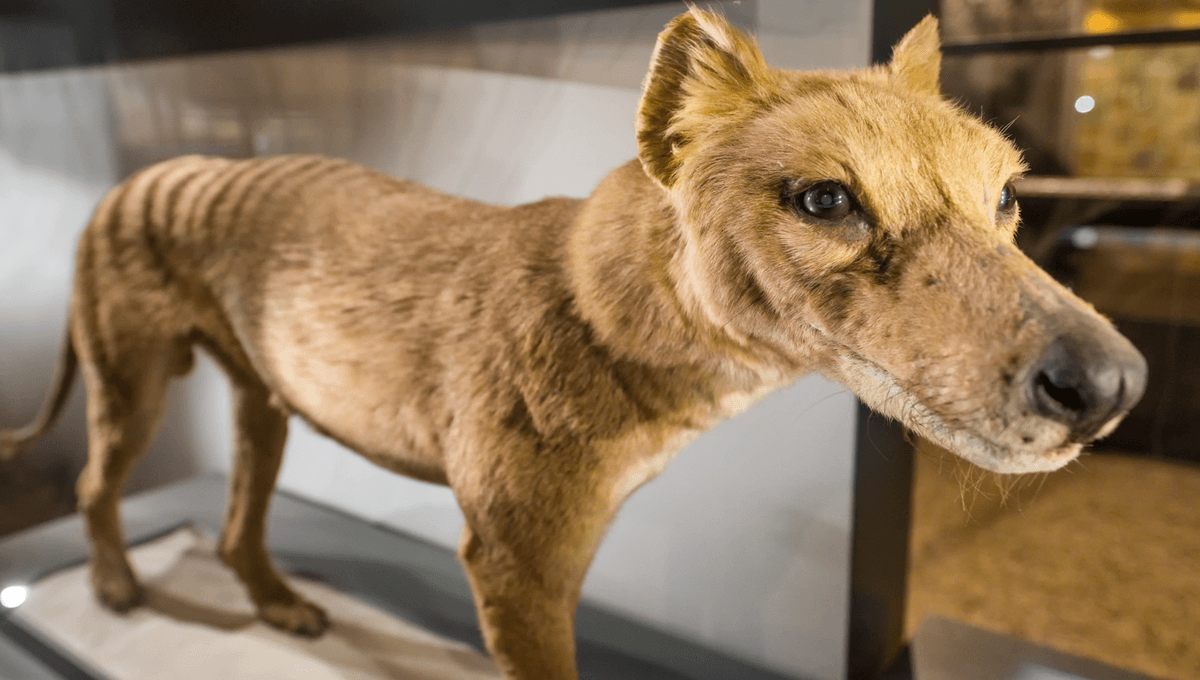
Scientists claim to have pieced together the most complete genome of a Tasmanian tiger to date – with the help of RNA from a head that’s been preserved in alcohol for over a century. The potential breakthrough is the latest chapter in an effort by Colossal Biosciences and the University of Melbourne’s Thylacine Integrated Genetic Restoration Research (TIGRR) Lab to resurrect the extinct animal, also known as a thylacine.
The team estimates that their new genome of the animal is over 99.9 percent accurate, which they say makes it “the most complete and contiguous ancient genome of any species to date.” Although it still contains 45 gaps, they aim to fix that with additional sequencing efforts in the coming months.
“This exceptional sample provides a fantastic opportunity for us to understand gene expression in thylacines. With this new resource in hand we will be able to determine what a thylacine could taste, what it could smell, what kind of vision it had and even how its brain functioned,” Dr Andrew Pask, a member of Colossal’s Scientific Advisory Board and the head of the Thylacine Integrated Genomic Restoration Research Laboratory at the School of BioSciences in the University of Melbourne, said in a statement.
It should be noted that this work is yet to be published in a peer-reviewed paper, although Dr Pask told ABC News that he expects that to happen by early next year. Given the lack of peer-reviewed data, some scientists in the field have called for caution when reading media headlines about possible de-extinctions in the near future.
Speaking to IFLScience in 2023, Ben Lamm, founder and CEO at Colossal Biosciences, explained how the recent genome sequencing would be extremely tricky without access to the remains of thylacine.
“There are animals that are extinct more recently than mammoths that went extinct in very hot and wet places. That’s not a great place for DNA. Cold, dry places are great. Things like caves or the Arctic, in the case of the permafrost,” Lamm told IFLScience.
“The thylacine went extinct in 1936, and people preserved some pups in ethanol for scientific study, so from that we were able to sequence a nearly complete genome […] Sometimes you get lucky, but generally speaking, the further back you go and the hotter, wetter places you are, it gets harder,” he added.
The ultimate aim of the project is the de-extinction of the thylacine. Once found throughout the Australian mainland and the islands of Tasmania and New Guinea, the carnivorous species looks a bit like a canine, but it is actually a marsupial that’s more closely related to the likes of kangaroos, koalas, wombats, wallabies, and bandicoots.
Humans and overhunting were largely responsible for the species’ demise. Although wiped out from mainland Australia around 3,000 years ago, a significant population lived in Tasmania after the arrival of European colonizers. Farmers put private bounties on the animals during the 1840s and they were even subjected to a government-sponsored extermination campaign in the 1880s.
The last confirmed individual died at a zoo in Hobart in 1936, although some controversial research has suggested that a wild population held on until the latter half of the 20th century – or perhaps even later.
Along with sequencing the thylacine genome, the researchers have been developing artificial reproductive technologies for marsupials – a vital move if the de-extinction of the species is to become a reality. Ultimately, this technology could be used to foster the growth of thylacine embryos. In the shorter term, however, the team hopes it will be utilized to assist in the survival of other marsupials.
“Not only are these major milestones for the thylacine de-extinction project, but Colossal’s advancements for improving Assisted Reproductive Technologies in marsupials can be applied across the marsupial family tree. These technologies will, for example, improve the breeding capacity of critically endangered species in captive populations – such as the closely related Tasmanian devils being bred to help fight against their extinction from the devil facial tumor disease,” added Pask.
It’s an exciting possibility, but there’s still a lot of work to do.
Source Link: Most Complete Thylacine Genome Yet Reconstructed In Push For De-Extinction, Company Claims